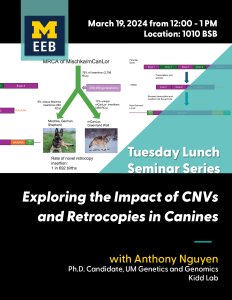Presented By: Ecology and Evolutionary Biology
EEB Tuesday Seminar Series - Exploring the Impact of CNVs and Retrocopies in Canines
with Anthony Nguyen Ph.D. Candidate, UM Genetics and Genomics, Kidd Lab

This is a part of our ongoing Tuesday Seminar Series.
Preview: Canines have proven time and time again to be an extremely useful modern organism, due to high inbreeding within their breed structure, heavy artificial selection, and reflection of human disease phenotypes. However, research on canine assemblies and structural variations have lagged behind human, mouse, or rat research due to a lack of genomic resources, and an important part of these are duplication. Large genomic duplications have gone relatively uninvestigated in modern canine research, largely due to the difficulties in assembling and assessing them properly as a result of their size and conflicting nature. In this investigation, with the recent explosion and availability of canine genomic researchers, we searched for structural variations, copy number variations, and retrocopies, which are all subcategories of genomic duplications. By comparing unique retrocopies across the nine canines we have available, and calculating the number of generations since genome divergence, we were able to determine a rate of novel retrocopy insertion at an average of 1/693 births. Together, our investigation illustrates both the difficulties of finding duplications and retrocopies, and highlights the variable representation of duplications across canines.
Preview: Canines have proven time and time again to be an extremely useful modern organism, due to high inbreeding within their breed structure, heavy artificial selection, and reflection of human disease phenotypes. However, research on canine assemblies and structural variations have lagged behind human, mouse, or rat research due to a lack of genomic resources, and an important part of these are duplication. Large genomic duplications have gone relatively uninvestigated in modern canine research, largely due to the difficulties in assembling and assessing them properly as a result of their size and conflicting nature. In this investigation, with the recent explosion and availability of canine genomic researchers, we searched for structural variations, copy number variations, and retrocopies, which are all subcategories of genomic duplications. By comparing unique retrocopies across the nine canines we have available, and calculating the number of generations since genome divergence, we were able to determine a rate of novel retrocopy insertion at an average of 1/693 births. Together, our investigation illustrates both the difficulties of finding duplications and retrocopies, and highlights the variable representation of duplications across canines.